Stihl FS 45 User Manual
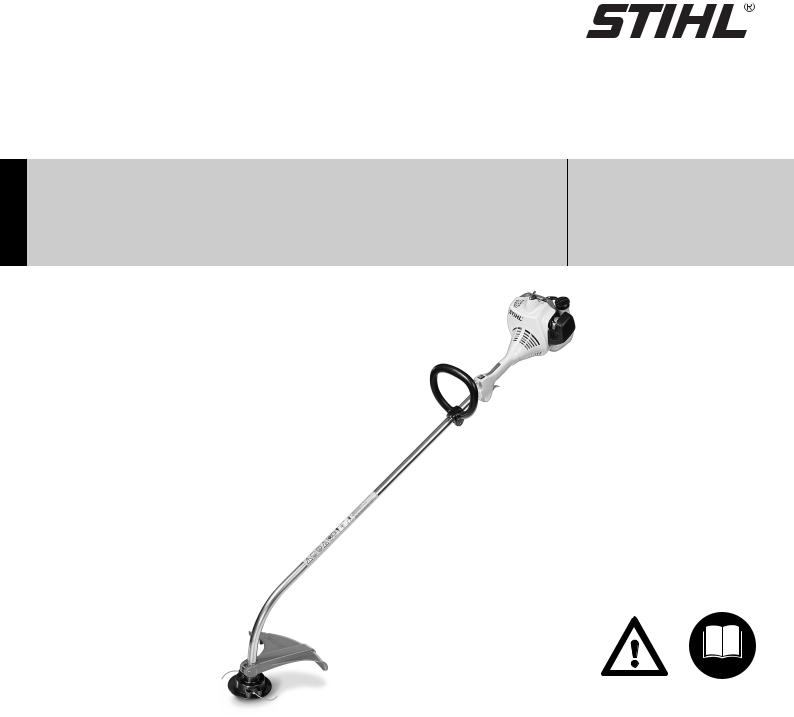
STIHL FS 45, 46
Instruction Manual Notice d’emploi
Contents
08.fm |
|
Guide to Using this Manual .............. |
2 |
|
|
Safety Precautions and |
3 |
||
01 |
|
Working Techniques ......................... |
||
006_ _ |
|
Approved Combinations of |
|
|
011 |
|
Cutting Tool, Deflector, |
|
|
|
Handle and Harness |
15 |
||
SE |
|
|||
|
Mounting the Loop Handle |
16 |
||
BA |
|
|||
|
Mounting the Deflector |
17 |
||
|
|
|||
|
|
Mounting Cutting Tools ................... |
17 |
|
|
|
Fuel ................................................ |
20 |
|
|
|
Fueling ............................................ |
21 |
|
|
recycled. |
Starting / Stopping the Engine ........ |
22 |
|
|
Operating Instructions |
25 |
||
|
|
|||
|
|
Cleaning the Air Filter ..................... |
25 |
|
|
can be |
Motor Management ........................ |
26 |
|
|
Adjusting the Carburetor ................ |
26 |
||
|
paper |
Catalytic Converter ......................... |
28 |
|
|
Checking the Spark Plug |
28 |
||
|
oils; |
|||
|
Inspections and Maintenance |
|
||
paper.free-chlorineon vegetablecontaininks |
by STIHL Service |
29 |
||
|
|
|||
|
|
Rewind Starter ................................ |
29 |
|
|
|
Storing the Machine ........................ |
30 |
|
|
|
Replacing the Nylon Line ............... |
30 |
|
|
|
Replacing the Nylon Line ............... |
32 |
|
Printed |
Printing |
Maintenance Chart ......................... |
34 |
|
Parts and Controls |
35 |
|||
|
|
|||
|
|
Specifications ................................. |
37 |
|
|
|
Special Accessories ....................... |
38 |
|
|
|
Maintenance and Repairs ............... |
38 |
|
|
in USA |
STIHL Limited Emission Control |
|
|
& Co. KG, 2006 |
Warranty Statement ........................ |
39 |
||
J6. CP. Printed |
|
|
||
© ANDREAS STIHL AG |
0458 232 8221 C. M0,5. |
STIHl |
|
|
English
Allow only persons who understand this manual to operate your trimmer.
To receive maximum performance and satisfaction from your STIHL trimmer, it is important that you read and understand the maintenance and safety precautions, starting on page 3, before using your trimmer.
Contact your STIHL dealer or the STIHL distributor for your area if you do not understand any of the instructions in this manual.
!Warning!
Because a trimmer is a high-speed cutting tool some special safety precautions must be observed to reduce the risk of personal injury.
Careless or improper use may cause serious or even fatal injury. Make sure your unit is equipped with the proper deflector, handle and harness for the type of cutting attachment being used. Always wear proper eye protection.
STIHL's philosophy is to continually improve all of its products. As a result, engineering changes and improvements are made from time to time. If the operating characteristics or the appearance of your trimmer differs from those described in this manual, please contact your STIHL dealer for information and assistance.
FS 45, FS 46 |
1 |

English
Guide to Using this Manual
Pictograms
All the pictograms attached to the machine are shown and explained in this manual.
The operating and handling instructions are supported by illustrations.
Symbols in text
The individual steps or procedures described in the manual may be marked in different ways:
:A bullet marks a step or procedure without direct reference to an illustration.
A description of a step or procedure that refers directly to an illustration may contain item numbers that appear in the illustration.
Example:
Loosen the screw (1) Lever (2) ...
In addition to the operating instructions, this manual may contain paragraphs that require your special attention. Such paragraphs are marked with the symbols described below:
Warning where there is a risk of an accident or personal injury or
serious damage to property.
 Caution where there is a risk of damaging the machine or its individual components.
Caution where there is a risk of damaging the machine or its individual components.


 Note or hint which is not essential for using the machine, but may improve the operator’s understanding of the situation and result in better use of the machine.
Note or hint which is not essential for using the machine, but may improve the operator’s understanding of the situation and result in better use of the machine.



 Note or hint on correct procedure in
Note or hint on correct procedure in 
 order to avoid damage to the environment.
order to avoid damage to the environment.
Equipment and features
This instruction manual may refer to several models with different features. Components that are not installed on all models and related applications are marked with an asterisk (*). Such components may be available as special accessories from your STIHL dealer.
Engineering improvements
STIHL’s philosophy is to continually improve all of its products. As a result, engineering changes and improvements are made from time to time. If the operating characteristics or the appearance of your machine differ from those described in this manual, please contact your STIHL dealer for assistance.
Therefore some changes, modifications and improvements may not be covered in this manual.
2 |
FS 45, FS 46 |

Safety Precautions and
Working Techniques
Warning!
Because a trimmer is a high-speed, fast-cutting
power tool, special safety precautions must be observed to reduce the risk of personal injury.
It is important that you read, fully understand and observe the following safety precautions and warnings. Read the owner's manual and the
safety instructions periodically. Careless or improper use of any trimmer may cause serious or fatal injury.
Have your STIHL dealer show you how to operate your trimmer. Observe all applicable local safety regulations, standards and ordinances.
!Warning!
Do not lend or rent your trimmer without the owner's manual. Be sure that anyone using your trimmer understands the information contained in this manual.
!Warning!
The use of any trimmer may be hazardous. If the rotating cutting tool comes in contact with your body, it will cut you. When it comes in contact with solid foreign objects such as rocks or bits of metal, it may fling them directly or by ricochet in the direction of bystanders or the operator. Striking such objects could damage the cutting tool. Thrown objects or damaged cutting tools may result in serious or fatal injury to the operator or bystanders.
!Warning!
Minors should never be allowed to use a trimmer. Bystanders, especially children, and animals should not be allowed in the area where a trimmer is in use.
Never let the trimmer run unattended.
Most of these safety precautions and warnings apply to the use of all STIHL trimmers. Different models may have different parts and controls. See the appropriate section of your owner's manual for a description of the controls and function of the parts of your model trimmer.
English
Safe use of a trimmer involves
1.the operator
2.the trimmer
3.the use of the trimmer.
THE OPERATOR!
Physical Condition
You must be in good physical condition and mental health and not under the influence of any substance (drugs, alcohol, etc.) which might impair vision, dexterity or judgement. Do not operate a trimmer when you are fatigued.
Be alert - if you get tired while operating your trimmer, take a break.
Tiredness may result in loss of control. Working with any trimmer can be strenuous. If you have any condition that might be aggravated by strenuous work, check with your doctor before operating a trimmer.
FS 45, FS 46 |
3 |

English
!Warning!
Prolonged use of a trimmer (or other machines) exposing the operator to vibrations may produce whitefinger disease (Raynaud's phenomenon) or carpal tunnel syndrome.
These conditions reduce the hand's ability to feel and regulate temperature, produce numbness and burning sensations and may cause nerve and circulation damage and tissue necrosis.
All factors which contribute to whitefinger disease are not known, but cold weather, smoking and diseases or physical conditions that affect blood vessels and blood transport, as well as high vibration levels and long periods of exposure to vibration are mentioned as factors in the development of whitefinger disease. In order to reduce the risk of whitefinger disease and carpal tunnel syndrome, please note the following:
:Most STIHL power tools are available with an anti-vibration ("AV") system designed to reduce the transmission of vibrations created by the engine to the operator's hands. An AV system is recommended for those persons using power tools on a regular or sustained basis.
:Wear gloves and keep your hands warm.
:Keep the AV system well maintained. A trimmer with loose components or with damaged or worn AV buffers will tend to have higher vibration levels.
:Maintain a firm grip at all times, but do not squeeze the handles with constant, excessive pressures and take frequent breaks.
All the above mentioned precautions do not guarantee that you will not sustain whitefinger disease or carpal tunnel syndrome. Therefore continual and regular users should monitor closely the condition of their hands and fingers. If any of the above symptoms appear, seek medical advice immediately.
!Warning!
The ignition system of the STIHL unit produces an electromagnetic field of a very low intensity. This field may interfere with some pacemakers. To reduce the risk of serious or fatal injury, persons with pacemaker should consult their physician and the pacemaker manufacturer before operating this tool.
Proper Clothing
!Warning!
To reduce the risk of injury, the operator should wear proper protective apparel.
!Warning!
The deflector provided with your trimmer may not protect the operator from all foreign objects (gravel, glass, wire, etc.) thrown by the rotating cutting tool. Thrown objects may also ricochet and strike the operator.
!Warning!
To reduce the risk of injury to your eyes never
operate a trimmer unless wearing goggles or properly fitted safety glasses with adequate top
and side protection complying with ANSI Z 87.1 (or your applicable national standard).
To reduce the risk of injury to your face STIHL recommends that you also wear a face shield or face screen over your goggles or safety glasses.
4 |
FS 45, FS 46 |
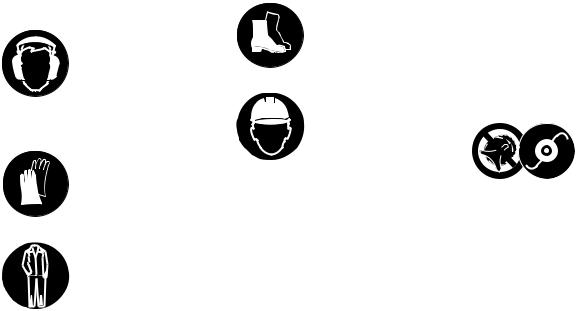
English
!Warning!
Trimmer noise may
damage your hearing. Wear sound barriers
(ear plugs or ear mufflers) to protect your hearing. Continual and regular
users should have their hearing checked regularly.
Protect your hands with gloves when handling the trimmer and the cutting tool. Heavy-duty, nonslip gloves improve your grip and protect your hands.
Clothing must be sturdy and snug-fitting, but allow
complete freedom of movement. Avoid loose-
fitting jackets, scarfs, neckties, jewelry, flared or
cuffed pants, unconfined longhair or anything that could become caught on branches, brush or moving parts of the unit. Wear long pants made of heavy material to protect your legs. Do not wear shorts, pants, sandals or go bare foot. Secure hair so it is above shoulder level.
Good footing is most important in trimmer work. Wear sturdy boots with nonslip soles. Steel-toed safety boots are recommended.
Wear an approved safety hard hat to reduce the risk of injury to your head when there is a danger of head injuries.
THE TRIMMER
For illustrations and definitions of the trimmer parts see the chapter on "Parts and Controls".
!Warning!
Never modify a trimmer in any way. Only attachments supplied by STIHL or expressly approved by STIHL for use with the specific STIHL trimmer models are authorized. Although certain unauthorized attachments are useable for the STIHL trimmer, their use may, in fact, be extremely dangerous.
!Warning!
To reduce the risk of injury to operator from blade contact, metal blades may be used on FS-trimmers equipped with a bicycle, "J" handle or loop handle with barrier bar and not on those FSand FE-models with a loop handle only.
Never use any metal cutting attachment on a FS-model that has a bent shaft.
FS 45, FS 46 |
5 |
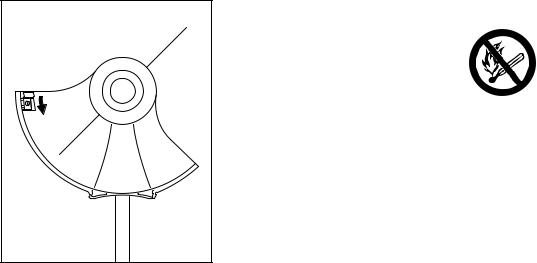
English
234BA004KN
THE USE OF THE TRIMMER
Transporting the trimmer
!Warning!
Always turn off the engine and make sure the cutting attachment has stopped before putting a trimmer down.
When transporting your trimmer in a vehicle, properly secure it to prevent turnover, fuel spillage and damage to the trimmer.
Preparation for the use of the trimmer
Adjust hand grip according to instructions in the owner's manual to suit your size before starting work.
Always check your trimmer for proper condition and operation before starting, particularly the throttle trigger, throttle trigger interlock (if applicable), stop switch, cutting tool, and deflector.
Arrows on the deflector show the correct direction of rotation of the cutting tool.
The throttle trigger must move freely and always spring back to the idle position. The cutting tool must be properly tightened and in safe operating condition. Inspect for loose parts (nuts, screws, etc.).
Fueling
Your STIHL trimmer uses an oil-gasoline mixture for fuel (see the chapter on "Fuel" of your owner's manual).
!Warning!
Gasoline is an extremely flammable fuel. If spilled and ignited by a spark or
other ignition source, it can cause fire and serious burn injury or property
damage. Use extreme caution when handling gasoline or fuel mix.
Do not smoke or bring any fire or flame near the fuel or trimmer.
Fueling Instructions
!Warning!
Fuel your trimmer in well-ventilated areas, outdoors. Always shut off the engine and allow it to cool before refueling. Gasoline vapor pressure may build up inside the gas tank depending on the fuel used, the weather conditions, and the venting system of the tank. In order to reduce the risk of burns and other personal injury from escaping gas vapor and fumes, remove the fuel filler cap on your trimmer carefully so as to allow any pressure build-up in the tank to release slowly. Never remove fuel filler cap while engine is running.
6 |
FS 45, FS 46 |
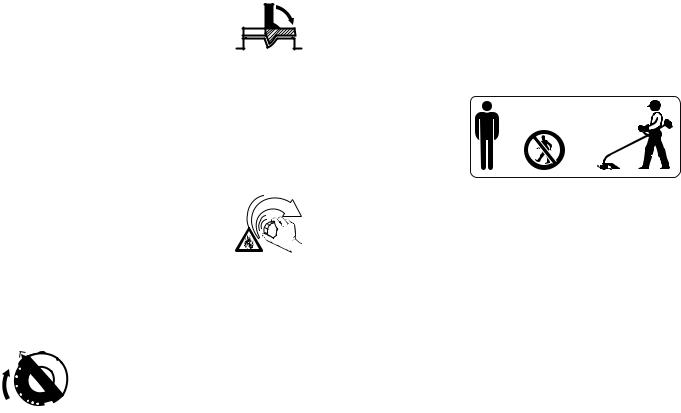
English
Select bare ground for fueling and move at least 10 feet (3 m) from the fueling spot before starting the engine. Wipe off any spilled fuel before starting your trimmer and check for leakage.
!Warning!
Check for fuel leakage while refueling and during operation. If fuel or oil leakage is found, do not start or run the engine until leak is fixed and spilled fuel has been wiped away. Take care not to get fuel on your clothing. If this happens, change your clothing immediately.
Different models may be equipped with different fuel caps.
Cap with Grip
!Warning!
In order to reduce the risk of fuel spillage and fire from an improperly tightened fuel cap, correctly position and tighten the fuel cap in the fuel tank opening.
To do this with this STIHL
cap, raise the grip on the
top of the cap until it is
upright at a 90° angle. Insert the cap in the fuel tank opening with the
triangular marks on the grip of the cap and on the fuel tank opening lining up. Using the grip, turn the cap firmly clockwise as far as it will go (approx. a quarter turn).
Fold the grip flush with the top of the cap. If the grip
does not lie completely flush with the cap and the detent on the grip does not fit in the
corresponding recess in the filler neck, the cap is not properly seated and tightened and you must repeat the above steps.
Screw Cap
!Warning!
Unit vibrations can cause an improperly tightened
fuel filler cap to loosen or
come off and spill
quantities of fuel.
In order to reduce the risk of fuel spillage and fire, tighten the fuel filler cap by hand with as much force as possible.
Starting
!Warning!
Your trimmer is a one-person machine. Once started, it may fling foreign objects for a great distance.
 15m (50ft)
15m (50ft)
To reduce the risk of eye and other injury insure that bystanders are at least
50 feet (15 m) away. Bystanders should be encouraged to wear eye protection. Stop the engine and cutting tool immediately if you are approached. Start and operate your trimmer without assistance. For specific starting instructions, see the appropriate section of your manual. Place the trimmer on firm ground or other solid surface in an open area. Maintain a good balance and secure footing.
FS 45, FS 46 |
7 |

English
!Warning!
To reduce the risk of injury from loss of control, be absolutely sure that the cutting tool is clear of you and all other obstructions and objects, including the
ground, because when the engine starts at starting-throttle, engine speed will be fast enough for the clutch to engage and turn the cutting tool.
!Warning!
When you pull the starter grip, don't wrap the starter rope around your hand. Do not allow the grip to snap back, but guide the starter rope to rewind it properly. Failure to follow this procedure may result in injury to hand or fingers and may damage the starter mechanism.
With the engine running but at idle, attach the trimmer to the spring hook of your harness (see appropriate chapter of this manual).
Catalytic converter
!Warning!
Some STIHL trimmer models are equipped with a catalytic converter, which is designed to reduce the exhaust emissions of the engine
by a chemical process in the muffler. Due to this process, the muffler does not cool down as rapidly as conventional mufflers when the engine returns to idle or is shut off. To reduce the risk of fire and burn injuries, the following specific safety precautions must be observed.
!Warning!
Since a muffler with a catalytic converter cools down less rapidly than conventional mufflers, always set your trimmer down in the upright position and never locate it where the muffler is near dry brush, grass, wood chips or other combustible materials while it is still hot.
Let the engine cool down sitting on concrete, metal, bare ground or solid wood (e.g. the trunk of a felled tree) away from any combustible substances.
!Warning!
To reduce the risk of fire or burn injury, let the unit cool down before refueling your trimmer after use.
!Warning!
Never disassemble or modify your muffler. The muffler could be damaged and cause an increase in heat radiation or sparks, thereby increasing the risk of fire or burn injury. You may also permanently damage the engine. Have your muffler serviced and repaired by your STIHL Servicing Dealer only.
!Warning!
To reduce the risk of fire or burn injury, keep the area around the muffler clean. Remove all debris such as pine needles, branches or leaves.
8 |
FS 45, FS 46 |

English
!Warning!
An improperly mounted or damaged cylinder housing or a damaged/ deformed muffler shell may interfere with the cooling effect of the catalytic converter. To reduce the risk of fire or burn injury, do not continue work with a damaged or improperly mounted cylinder housing or a damaged/ deformed muffler shell. Your catalytic converter is furnished with screens designed to reduce the risk of fire from the emission of hot particles. Due to the heat from the catalytic reaction, these screens will normally stay clean and need no service or maintenance. If you experience loss of performance and you suspect a clogged screen, have your muffler maintained by a STIHL Servicing Dealer.
Working Conditions
Operate and start your trimmer only outdoors in a ventilated area. Operate the trimmer under good visibility and daylight conditions only. Work carefully.
!Warning!
Your trimmer produces toxic exhaust fumes as soon as the engine is running. These gases (e.g. carbon monoxide) may be colorless and
odorless. To reduce the risk of serious or fatal injury from inhaling toxic fumes, never run the trimmer indoors or in poorly ventilated locations.
!Warning!
Use of this product can generate dust and fumes containing chemicals known to cause respiratory disease, cancer, birth defects, or other reproductive harm. If you are unfamiliar with the risks associated with the particular dust or fume at issue, consult your employer, governmental agencies such as OSHA and NIOSH, and other sources on hazardous materials. California and some other authorities, for instance, have published lists of substances known to cause cancer, reproductive toxicity, etc. Control dust and fumes at the source where possible. In this regard use good work practices and follow the recommendations of OSHA/NIOSH and occupational and trade associations.
When the inhalation of toxic dust and fumes cannot be eliminated, the operator and any bystanders should always wear a respirator approved by NIOSH / MSHA for the type of dust and / or fumes encountered."
!Warning!
The muffler and other parts of the engine (e.g. fins of the cylinder, spark plug) become hot during operation and remain hot for a while after stopping the engine. To reduce risk of burns do not touch the muffler and other parts while they are hot.
Do not cut any material other than weed or similar soft vegetation. The cutting tools may be used only for the operations described in your manual.
FS 45, FS 46 |
9 |
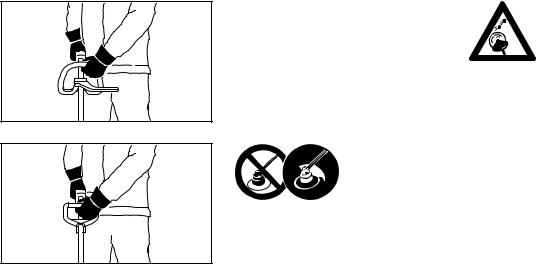
English
002BA057 KN
002BA056 KN
Always hold the trimmer firmly with both hands. Wrap your fingers tightly around the handles, keeping the handles cradled between your thumb and forefinger. Keep your hands in this position to have your trimmer under control at all times. Make sure your trimmer handles and grip are in good condition and free of moisture, pitch, oil or grease.
!Warning!
Never attempt to operate any trimmer with one hand. Loss of control of the trimmer resulting in serious or fatal injury may result.
!Warning!
To reduce the risk of bodily injury resulting from loss of control and/or contact with the cutting tool, make sure your unit is equipped with the proper handle and harness for the type of cutting attachment being used.
!Warning!
To reduce the risk of injury from thrown objects and blade contact, never operate a
trimmer without a properly mounted deflector. Keep the deflector (and the skirt where appropriate) adjusted properly at all times (see chapter on mounting the various cutting tools of your owner's manual). Do not overreach. Keep proper footing and balance at all times. Special care must be taken in slippery conditions (wet ground, snow) and in difficult, overgrown terrain. Watch for hidden obstacles such as tree stumps, roots and ditches to avoid stumbling. Be extremely cautious when working on slopes or uneven ground.
Before cutting, inspect the area for stones, glass, pieces of metal, trash or other solid objects. The
cutting attachment could throw objects of this kind.
!Warning!
This trimmer is normally to be used at ground level with the cutting attachment parallel to the ground. Use of a trimmer above ground level or with the cutting attachment perpendicular to the ground may increase the risk of injury, since the cutting attachment is more fully exposed and the trimmer may be more difficult to control. Never use your trimmer as a hedge trimmer.
Do not operate using the starting throttle lock as you do not have control of the engine speed. See section of your owner's manual on the proper use of the slide control.
If the cutting tool or deflector becomes clogged or stuck, always turn off the engine and make sure the cutting tool has stopped, before cleaning. Grass, weeds, etc. should be cleaned off the cutting tool at regular intervals.
10 |
FS 45, FS 46 |

English
!Warning!
During cutting, check the tightness and the condition of the cutting tool at regular intervals. If the behavior of the tool changes, stop the engine immediately, and check the nut securing the tool for tightness and the cutting tool for cracks and damage. Replace damaged cutting tools immediately. Such tools may shatter at high speed and cause serious or fatal injury.
!Warning!
Keep hands and feet away from cutting tool.
Never touch a rotating
cutting tool with your hand or any part of your body. It continues to rotate for a
short period after the throttle trigger is released (flywheel effect).
Important adjustments
!Warning!
To reduce the risk of personal injury from loss of control or contact with the running cutting tool, do not use a cutting tool with incorrect idle adjustment.
At correct idle speed, the cutting tool should not move. For directions on how to adjust idle speed, see the appropriate section of your owner's manual.
If you cannot set the correct idle speed, have your STIHL dealer check your trimmer and make proper adjustments and repairs.
MAINTENANCE, REPAIR AND STORING
Maintenance, replacement, or repair of the emission control devices and systems may be performed by any nonroad engine repair establishment or individual. However if you claim warranty for a component which has not been serviced or maintained properly or if non-approved replacement parts were used, STIHL may deny warranty.
!Warning!
Use only STIHL replacement parts for maintenance and repair.
Use of non-STIHL parts may cause serious or fatal injury.
Follow the maintenance and repair instructions in the appropriate section of your owner's manual. Please refer to the maintenance chart on the last pages of this manual.
!Warning!
Always stop the engine and make sure that the cutting tool is stopped before doing any maintenance or repair work or cleaning the trimmer. Do not attempt any maintenance or repair work not described in your owner's manual. Have such work performed at your STIHL service shop only.
FS 45, FS 46 |
11 |
English
!Warning!
Never repair damaged cutting tools by welding, straightening or modifying the shape. This may cause parts of the cutting tool to come off and result in serious or fatal injuries.
!Warning!
Check condition of cutting tool at regular short intervals. If behavior of tool changes, check it immediately for tightness or any signs of cracks in particular. Replace damaged or dull cutting tools immediately, even if they have only superficial cracks. If the
tool loosens after being properly tightened, the retaining nut may be worn or damaged and should be replaced. If the tool continues to loosen, see your STIHL dealer.
!Warning!
To reduce the risk of fire and burn injuries, check fuel filler cap for leaks at regular intervals. Use the specified spark plug and make sure it and the ignition lead are always clean and in good condition.
!Warning!
Never test the ignition system with ignition wire terminal removed from spark plug or with unseated spark plug, since uncontained sparking may cause a fire.
!Warning!
To reduce the risk of fire and burn injury, use only spark plugs authorized by STIHL. Always press spark plug boot snugly onto spark plug terminal of the proper size. (Note: If terminal has detachable SAE adapter nut, it must be attached.) A loose connection between spark plug terminal and ignition wire connector in the boot may create arcing that could ignite combustible fumes and cause a fire. Keep spark plug clean, and make sure ignition lead is in good condition.
!Warning!
Do not operate your trimmer if the muffler is damaged, missing or modified. An improperly maintained muffler will increase the risk of fire and hearing loss. Never touch a hot muffler or burn will result. If your muffler was equipped with a spark-arresting screen to reduce the risk of fire, never operate your trimmer if the screen is missing or damaged. Do not modify or remove any part of the muffler or spark arresting screen.
Remember that the risk of forest fires is greater in hot or dry weather.
Tighten all nuts, bolts and screws, except the carburetor adjustment screws, after each use.
Additionally, the daily maintenance schedule for your trimmer set forth in your STIHL Owner's Manual should be strictly followed.
For any maintenance please refer to the maintenance chart and to the warranty statement near the end of this manual.
Store trimmer in a dry, high or locked location out of reach of children.
Before storing for longer than a few days, always empty the fuel tank.
12 |
FS 45, FS 46 |
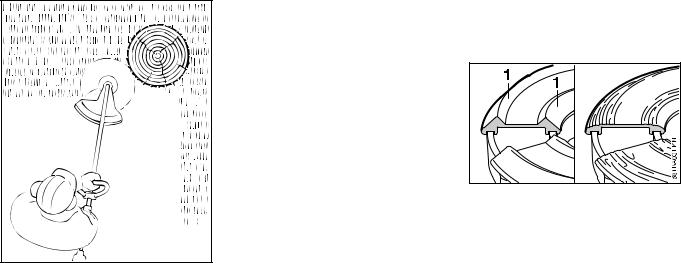




 000BA019 KN
000BA019 KN
USING THE CUTTING TOOLS
For an illustration of the various cutting tools and instructions on proper mounting see the chapter on "mounting the cutting head" in your owner's manual.
Using the mowing heads
The STIHL AutoCut, PolyCut, and FixCut mowing heads produce a clean and tidy finish.
They are to be used only on trimmers equipped with a limiter blade in the deflector in order to keep the line at the proper length (see "Parts and Controls" chapter of this manual).
English
If the lawn edges are planted with trees or bordered by a fence etc., it is best to use a nylon line head. It achieves a "softer" cut with less risk of damaging tree bark etc. than with the polymer blades.
However, the polymer bladed STIHL "PolyCut" produces a better cut if there are no plants along the edge of the lawn. Sharpening is not necessary and worn cutting blades are easily replaced.
!Warning!
To reduce the risk of serious injury, never use wire or metal-reinforced line or other material in place of the nylon cutting lines. Pieces of wire could break off and be thrown at high speed toward the operator or bystanders.
STIHL AutoCut mowing head
Nylon cutting cord advances automatically when tapped against the ground.
STIHL FixCut
Uses pre-cut lengths of nylon line.
Observe wear indicators.
Do not continue using the mowing head if the raised moldings (1) on the base are missing or worn – see right illustration above. The mowing head may otherwise shatter and flying objects could result in injury to the operator or bystanders. Install a new mowing head.
FS 45, FS 46 |
13 |
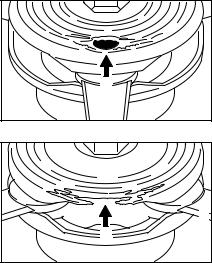
English
STIHL PolyCut 6-3 mowing head
Uses either nylon lines or nonrigid plastic blades
1
002BA073 KN
2
!Warning!
002BA074 KN
Wear limit marks are integrated in the base of the PolyCut.
Do not use the PolyCut 6-3 if one of the circular holes (1) starts to become visible or if the projecting rim (2) has worn away, since the cutting tool may otherwise shatter and flying objects could result in injury to the operator or bystanders.
14 |
FS 45, FS 46 |
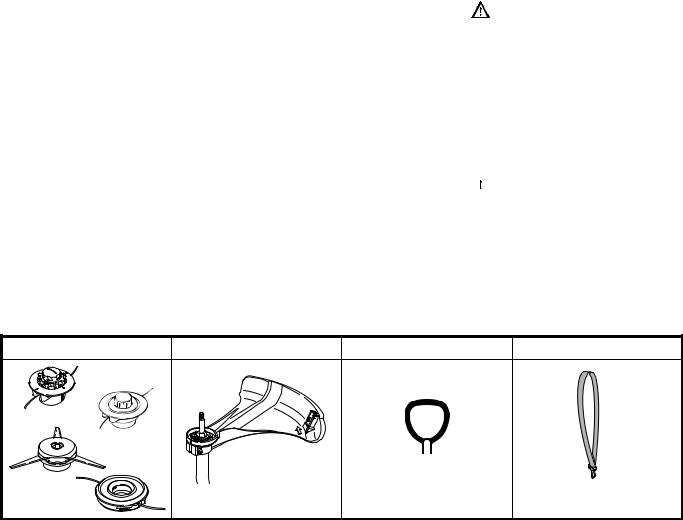
English
Approved Combinations of Cutting Tool, Deflector, Handle
and Harness
Cutting Tools
1STIHL AutoCut C 5-2 mowing head
2STIHL AutoCut 5-2 mowing head
3STIHL PolyCut 6-3 mowing head
4STIHL FixCut 5-2 mowing head
Deflector
5Deflector with line limiting blade for mowing heads only (see “Mounting the Deflector”)
Handle
6 Loop handle
Harness/Shoulder Strap
7 Shoulder strap may be used
Equipment
The complete trimmer includes:
–Cutting tool
–Deflector
–Handle
–Shoulder strap (special accessory)
Select the correct combination from the table according to the cutting tool you intend to use. Read the table horizontally from left to right.
Warning!
To reduce the risk of injury from thrown objects or blade contact, never operate your unit without the proper deflector for the cutting attachment being used. To reduce the risk of injury from loss of control and / or contact with the cutting tool, make sure your unit is equipped with a proper handle for the type of cutting attachment being used.
 Warning!
Warning!
Only mowing heads (1, 2, 3, 4) may be used on loop-handled trimmers with a curved drive tube.
To reduce the risk of accidents and injury, avoid contact with the rotating cutting tool.
Cutting Tools |
Deflector |
Handle |
Shoulder Strap |
1 |
5 |
|
|
213681FKKN |
|
|
|
|
|
|
|
3 |
KN |
6 |
|
|
|
||
|
681FK028 |
|
7 |
|
|
|
|
4 |
|
|
|
002BA125 KN
FS 45, FS 46 |
15 |

English
Mounting the Loop Handle
223BA017 KN
223BA018 KN
|
A |
|
|
1 |
|
|
|
2 |
6 |
|
|
5 |
3 |
|
|
|
|
|
4 |
KN |
|
232BA069 |
|
|
|
Adjusting loop handle to most comfortable position
:Loosen the wingnut (6).
:Slide or rotate the loop handle (1) on the drive tube as required.
:Tighten the wingnut (6).
: Place friction liner in the loop handle |
: |
Fit the loop handle (1) on the drive |
|
|
tube, approx. 20 cm (8 in) (A) |
|
|
forward of the control handle (2). |
|
: |
Push the spacer (3) (not all markets) |
|
|
into the loop handle until it fits |
|
|
snugly. |
|
: |
Insert the screw (4) through the loop |
|
|
handle and the spacer so that the |
|
|
screw head locates in the hexagon |
|
|
recess. |
: Fit the washer (5) and wingnut (6) and tighten down firmly.
16 |
FS 45, FS 46 |

English
Mounting the Deflector |
Mounting Cutting Tools |
2


1 
 KN232BA066
KN232BA066
4
3 |
KN |
|
232BA067 |
:Push the deflector (1) over the clamp (2).
:Insert nut (3) in the hex recess in the deflector.
:Make sure the holes line up.
:Fit screw (4) and tighten it down firmly.
232BA026 KN |
Preparations |
:Lay your trimmer on its back with the loop handle and shroud pointing down and the output shaft facing up.
1
3
 2 4
2 4
232BA033 KN
Thrust Plate
The thrust plate is shipped with the Polycut 6-3 and FixCut 5-2. It is only required for these mowing heads.
AutoCut 5-2 mowing head AutoCut C 5-2 mowing head
:Pull the thrust plate (1) (if fitted) off the shaft (2).
STIHL PolyCut 6-3 mowing head, STIHL FixCut 5-2 mowing head
:Slip the thrust plate (1) over the shaft (2) and engage hexagon recess (3) on external hexagon (4).
FS 45, FS 46 |
17 |
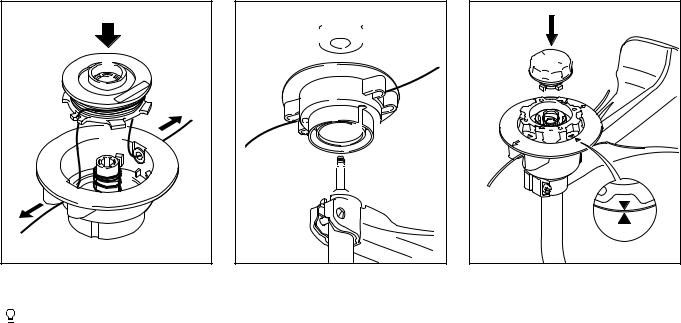
English
4
2 |
3 |
|
1 |
|
KN |
3 |
232BA054 |
|
Mounting the Mowing Head


 Keep instruction sheet for mowing
Keep instruction sheet for mowing
head in a safe place.
Assembling STIHL AutoCut 5-2
:Fit the spring (1) in the head (2).
All other steps are described in the instruction sheet provided.
:Wind the nylon lines (3) onto the spool (4).
:Thread the ends of the nylon lines through the sleeves and place the spool in the head.
 8
8
2
 7
7
 5
5
6 



232BA053 KN
STIHL AutoCut 5-2
:Push the mowing head (2) over the shaft (5) and engage the hex recess (7) on the external hexagon (6).
:Place the cap (8) on the head – turn it clockwise as far as stop and then tighten it down firmly.
8 
2 ES
2 |
9 |
Schnur/LINE |
|
|
1 |
681BA018 KN
STIHL AutoCut C 5-2
:Push the mowing head (2) over the shaft – as with the AutoCut 5-2.
:Screw the spool (9) into the head until the two arrow points are in alignment (see illustration) – secure the spool in this position.
:Push the cap (8) into the spool as far as stop, turning it clockwise at the same time.
:Turn cap as far as stop and tighten
it down by hand.
18 |
FS 45, FS 46 |
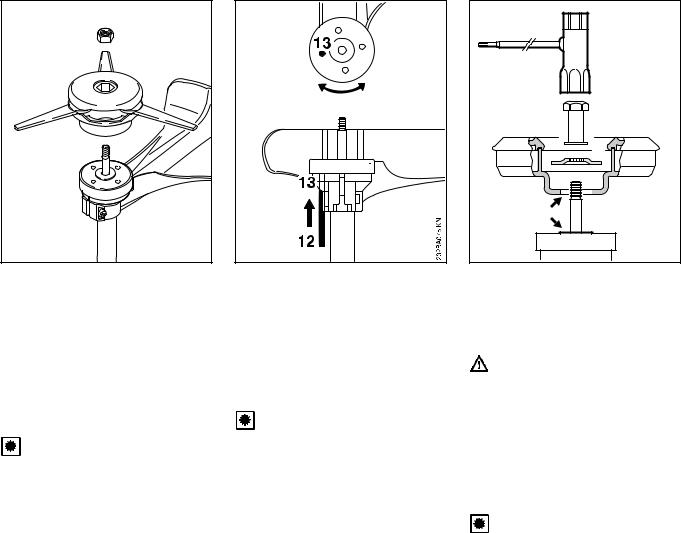
10 |
11 |
5 |
681BA019 KN |
STIHL Polycut 6-3 |
:Fit the thrust plate on the shaft.
:Insert mounting nut (10) in the mowing head.
:Screw mowing head (11) clockwise onto the shaft (5) as far as stop.
:Block the output shaft with the stop pin.
:Tighten down the mowing head.
 Remove the tool used to block the shaft.
Remove the tool used to block the shaft.
Blocking the shaft
:Block the shaft by pushing the stop pin (12) through the holes (13) in the deflector and thrust plate – turn the thrust plate back and forth if necessary.
:Tighten down the mowing head firmly.
 Remove the tool used to block the shaft.
Remove the tool used to block the shaft.
|
|
English |
5 |
|
|
4 |
|
|
3 |
|
|
1 |
|
KN |
|
|
|
|
2 |
232BA074 |
|
|
|
STIHL FixCut 5-2 |
|
|
:Fit the thrust plate (2) on the shaft.
:Place the mowing head on the thrust plate (2).
Collar (arrow) must locate in the mowing head’s mounting hole.
:Push the thrust washer (3) over the shaft (1) so that it locates against the base.
:Block the output shaft.
:Use the combination wrench (5) to screw the mounting nut (4) counterclockwise onto the output shaft and it tighten down firmly.
 Remove the tool used to block the shaft.
Remove the tool used to block the shaft.
FS 45, FS 46 |
19 |
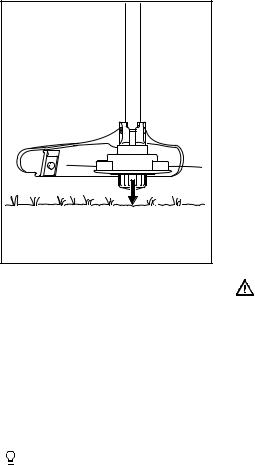
English |
2 |
1 |
232BA007 KN |
Adjusting Nylon Line
STIHK AutoCut
:old the rotating cutting head horizontal to the ground – tap it on the ground – about 1 1/4" (3 cm) fresh line is advanced.
:The blade (1) on the deflector (2) trims surplus line to the correct length. Avoid tapping the head more than once.


 Line feed operates only if both lines still have a minimum length of 1" (2.5 cm).
Line feed operates only if both lines still have a minimum length of 1" (2.5 cm).
Removing the Mowing Head
STIHL AutoCut
:Hold the mowing head steady and unscrew the cap counterclockwise.
STIHL PolyCut
:Block the shaft.
:Unscrew the mowing head counterclockwise.
STIHL FixCut
:Block the shaft.
:Use the combination wrench to loosen and unscrew the mounting nut clockwise from the output shaft.
If the mounting nut is too loose, fit a new one.
Replacing Nylon Line / Cutting Blades
STIHL AutoCut
See chapter on "Replacing Nylon Line".
STIHL PolyCut, FixCut
Refer to instructions supplied with the mowing head.
Fuel
This engine is certified to operate on unleaded gasoline and with the mix ratio 50:1.
Your engine requires a mixture of highquality premium gasoline and highquality two-stroke air-cooled engine oil.
Use premium branded unleaded gasoline with a minimum octane rating of 89 RON.
Note: Models equipped with a catalytic converter require unleaded gasoline. A few tankfuls of leaded gasoline can reduce the efficiency of the catalytic converter by more than 50%.
Fuel with a lower octane rating may result in preignition (causing "pinging") which is accompanied by an increase in engine temperature. This, in turn, increases the risk of the piston seizure and damage to the engine.
The chemical composition of the fuel is also important. Some fuel additives not only detrimentally affect elastomers (carburetor diaphragms, oil seals, fuel lines etc.), but magnesium castings as well. This could cause running problems or even damage the engine. For this reason it is essential that you use only high-quality fuels!
20 |
FS 45, FS 46 |
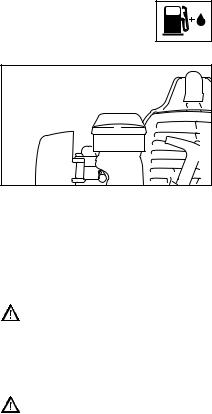
Fuels with different percentages of ethanol are being offered. Ethanol can affect the running behaviour of the engine and increase the risk of lean seizure.
Use only STIHL two-stroke engine oil or equivalent high-quality two-stroke aircooled engine oils for mixing.
We recommend STIHL 50:1 two-stroke engine oil since it is specially formulated for use in STIHL engines.
Do not use BIA or TCW (two-stroke water cooled) mix oils!
Use only STIHL 50:1 heavy-duty engine oil or an equivalent quality twostroke engine oil for the fuel mix in models equipped with a catalytic converter.
Take care when handling gasoline. Avoid direct contact with the skin and avoid inhaling fuel vapour.
The canister should be kept tightly closed in order to avoid any moisture getting into the mixture.
The fuel tank and the canister in which fuel mix is stored should be cleaned from time to time.
Fuel mix ratio
Only mix sufficient fuel for a few days work, not to exceed 3 months of storage. Store in approved safety fuel-canisters only. When mixing, pour oil into the canister first, and then add gasoline.
Examples |
|
|
|
Gasoline |
Oil (STIHL 50:1 or |
||
|
|
equivalent high-quality |
|
|
|
oils) |
|
liters |
liters |
(ml) |
|
|
1 |
0.02 |
(20) |
5 |
0.10 |
(100) |
|
10 |
0.20 |
(200) |
|
15 |
0.30 |
(300) |
|
20 |
0.40 |
(400) |
|
|
25 |
0.50 |
(500) |
Dispose of empty mixing-oil canisters only at authorized disposal locations.
English
Fueling
232BA046 KN
Before fueling, clean the filler cap and the area around it to ensure that no dirt falls into the tank.
Always thoroughly shake the mixture in the canister before fueling your machine.
In order to reduce the risk of burns or other personal injury from
escaping gas vapor and fumes, remove the fuel filler cap carefully so as to allow any pressure build-up in the tank to release slowly.
After fueling, tighten fuel cap as securely as possible by hand.
FS 45, FS 46 |
21 |
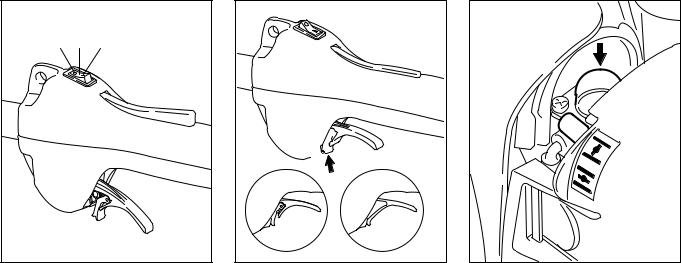
English
Starting / Stopping
the Engine
3 1 2
4
|
5 |
7 6 |
KN |
|
232BA064 |
Controls
Stop switch (1) with positions: I - normal run position (2) and O - stop (3).
Throttle trigger interlock (4).
Throttle trigger (5) with tongue (6) and catch (7).

 6
6
232BA065 KN
Starting
:Move the stop switch to position I.
:Press down the throttle trigger interlock and hold it there.
:Squeeze the throttle trigger until the catch on the tongue (6) can be engaged in the housing (arrow).
:Now release the throttle trigger, tongue and throttle trigger interlock in that order. This is the starting throttle position.
9
8
232BA011 KN
:Set the choke lever (8):
For cold start to g
For warm start to e
– also use this position if the engine has been running but is still cold.
:Press fuel pump bulb (9) at least five times even if bulb is filled with fuel.
22 |
FS 45, FS 46 |
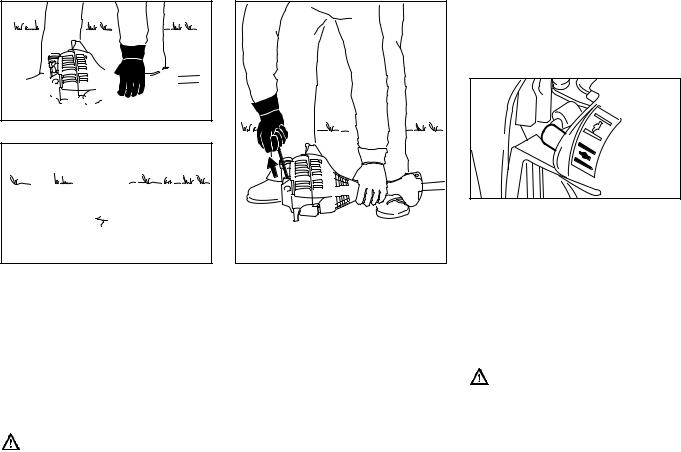
English



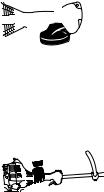 232TI013 KN 232BA012 KN
232TI013 KN 232BA012 KN
:Put the unit on the ground: It must rest securely on the engine support and deflector.
Check that the cutting tool is not touching the ground or any other obstacles.
:Make sure you have a firm footing: Hold the unit with your left hand and press it down firmly – your thumb should be under the housing.
Do not stand or kneel on the drive tube!
232BA014 KN |
Standard versions:
:Pull the starter grip slowly with your right hand until you feel it engage – and then give it a brisk strong pull. Do not pull out the starter rope all the way – it might break.
Versions with ErgoStart:
:Pull the starter grip slowly with your right hand until you feel the first stop
– and then pull it out slowly and steadily.
Do not pull out the starter rope to its full length – it might break.
:Do not let the starter grip snap back. Guide it slowly back into the housing so that the starter rope can rewind properly.
8
232TI015 KN
:Continue cranking until engine runs.
:After no more than 5 pulls, move the choke lever eand continue cranking.
As soon as the engine runs
:Squeeze throttle until the tongue disengages – the engine will settle down to idle speed.
Make sure the carburetor is
correctly adjusted – the cutting tool must not rotate when the engine is idling.
Your machine is now ready for operation.
FS 45, FS 46 |
23 |
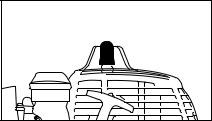
English
To shut down the engine:
:Move the stop switch to O.
If the engine does not start
Choke lever
If you did not move the choke lever to e quickly enough after the engine began to fire, the combustion chamber has flooded.
:Set the choke lever to e
:Move stop switch to I, interlock lever and throttle trigger to starting throttle position.
:Start the engine by pulling the starter rope firmly. 10 to 20 pulls may be necessary.
If the engine still does not start
10 |
232BA048 KN |
:Move stop switch to O.
:Pull off the spark plug boot (10).
:Unscrew and dry off the spark plug.
:Open the throttle wide.
:Crank the engine several times with the starter to clear the combustion chamber.
:Refit the spark plug.
:Connect the spark plug boot – push it down firmly.
:Move the stop switch to I
:Set choke lever to e
– even if engine is cold.
:Now start the engine.
Fuel tank run until dry
:After refueling, press the fuel pump bulb at least fives times even if the bulb is filled with fuel.
:Set the choke lever according to engine temperature.
:Now start the engine.
24 |
FS 45, FS 46 |
